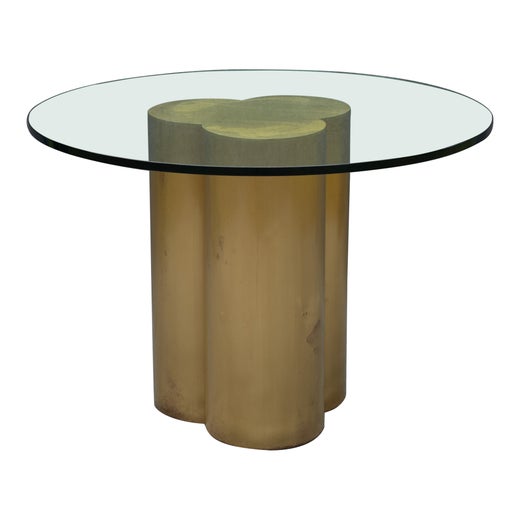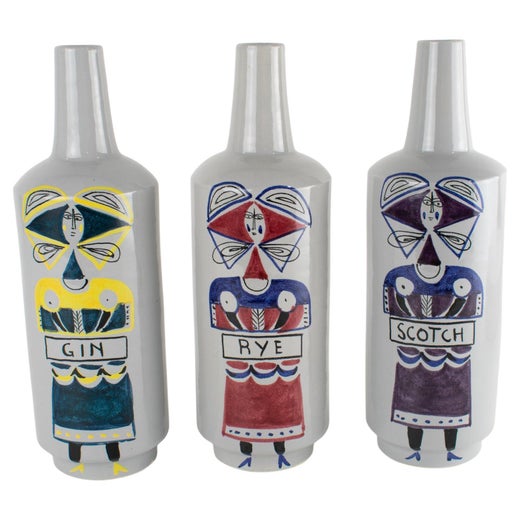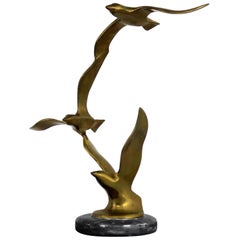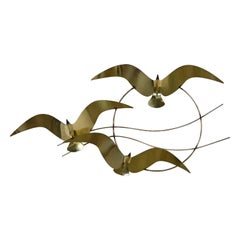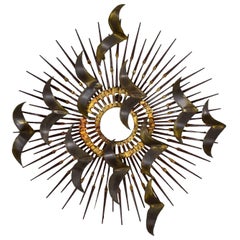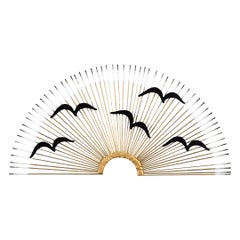Curtis Jere Bronze Sculpture, Three Birds in Flight
About the Item
- Creator:Curtis Jeré (Designer),Raymor (Manufacturer)
- Attributed to:Gumps (Retailer)
- Dimensions:Height: 22 in (55.88 cm)Width: 5 in (12.7 cm)Depth: 4.5 in (11.43 cm)
- Style:Mid-Century Modern (Of the Period)
- Materials and Techniques:
- Place of Origin:
- Period:
- Date of Manufacture:circa 1960
- Condition:Wear consistent with age and use. We have found no flaws but wear is consistent with age and use.
- Seller Location:Topeka, KS
- Reference Number:Seller: ARN-DEC-0011stDibs: LU187334258503
Curtis Jeré
Though the name Curtis Jeré is familiar to many as the maker of ebullient and eccentric modern design from the 1960s and ‘70s, relatively few are aware that it is a pseudonym for the design team of Curtis Freiler and Jerry Fels. Together, the two created some of the most striking and vivid furnishings and decorative objects of their era, from sculptures and dynamically framed mirrors, to lighting and wall decorations.
New Yorkers Freiler and Fels had collaborated for two decades on small jewelry lines before launching a design company called Artisan House in 1964. They combined variants of their names to create an artful persona — sometimes shortened to C. Jeré; the "surname" is pronounced with a rising inflection: jhayr-EH — that stood behind large-scale decorative metalwork, marked by semi-abstract petal forms with burnt and brazed edges. Fels served as head of design, and Freiler, known for his keen handiwork, was the production chief. The pair’s eclectic metalwork has captivated decorative art collectors and interior designers ever since.
The work of Curtis Jeré displays a sense of playfulness and curiosity, while drawing on inspirations and themes that include flowers, discs, geometric forms and animal figures. Freiler and Fels had a masterful ability to work with different materials, such as patinated brass and brilliant chrome.
The price of a Curtis Jeré mirror, lamp, wall-mounted sculpture or tabletop sculpture can range from $400 to $12,000, depending on the size, the rarity of the piece, the intricacy of the metalwork and the materials used in its construction. Other factors like condition can affect the perceived value and, thus, the cost of works by Curtis Jeré.
As you will see on 1stDibs, the imaginative powers of the designers of Curtis Jeré pieces were boundless, and their creations will add a dash of verve in any room.
Raymor
Few had their finger on the pulse of American furniture like importer and distributor Raymor. Founder Irving Richards first had his eyes opened to the world of furniture while attending the 1928 Salon d’Automne art and design fair in Paris. He joined Lightolier two years later and developed its business relationships, including with designer Russel Wright.
Wright and Richards met in 1935 and Russel Wright, Inc. was formed in 1936. Its American Modern ceramic tableware, produced under the name Wright Accessories in 1938, was a notably lucrative collaboration. Following the early success of American Modern, Richards obtained the majority share of Wright Accessories and changed its name to Raymor Mfg Division Inc. in 1941.
By 1952, the exclusivity over American Modern had ended (the line was initially produced by Wright Associates and later manufactured by Steubenville for two decades). To keep up with American markets, Raymor worked with prominent designers such as George Nelson, Arthur Umanoff, Ray and Charles Eames, and Hans J. Wegner.
The company’s imports expanded to Denmark, which contributed to the rise of Scandinavian modern designs in the American market. Throughout the 1950s, Richards established relationships with factories in Scandinavia, Italy and Germany, as well as with the influential tastemaker and importer Charles Stendig.
The furniture company Simmons bought Raymor in 1963 and changed its name to Raymor Richards, Morgenthau Inc. in 1969. During that time, Raymor’s Omnibus range of Scandinavian-style wall units became widely popular, along with Italian glass and pottery like Bitossi ceramics designed by Aldo Londi and Bagni ceramics by Alvino Bagni.
Shifting styles coupled with rising competition, and the departure of Richards from the company, ended Raymor. By the late 1970s, Raymor faced a wave of international factories able to produce similar products of lesser quality for a lower cost. Buyers were eager to frequently change their interior styles, limiting the need for high-end, durable furniture, which Raymor had been importing.
On 1stDibs, find a collection of vintage Raymor ceramics, lamps, decorative objects and more.
You May Also Like
20th Century American Mid-Century Modern Animal Sculptures
Stone, Bronze
Vintage 1970s American Mid-Century Modern Abstract Sculptures
Metal
Vintage 1970s Unknown Mid-Century Modern Animal Sculptures
Rock Crystal, Metal, Brass, Bronze
Late 20th Century American Mid-Century Modern Figurative Sculptures
Onyx, Brass
Mid-20th Century American Mid-Century Modern Animal Sculptures
Marble, Brass
Late 20th Century American Mid-Century Modern Abstract Sculptures
Metal
Mid-20th Century American Brutalist Animal Sculptures
Stone, Iron
Mid-20th Century American Mid-Century Modern Animal Sculptures
Quartz, Metal
Vintage 1970s American Mid-Century Modern Animal Sculptures
Stone, Metal
Vintage 1960s American Mid-Century Modern Animal Sculptures
Wire, Steel
More From This Seller
View All20th Century American Mid-Century Modern Animal Sculptures
Marble, Brass
Vintage 1980s American Modern Wall-mounted Sculptures
Metal, Brass
20th Century American Brutalist Wall-mounted Sculptures
Metal, Brass
Mid-20th Century Unknown Brutalist Wall-mounted Sculptures
Metal
Late 20th Century American Modern Abstract Sculptures
Metal, Brass, Copper, Stainless Steel
Mid-20th Century American Organic Modern Decorative Bowls
Bronze
